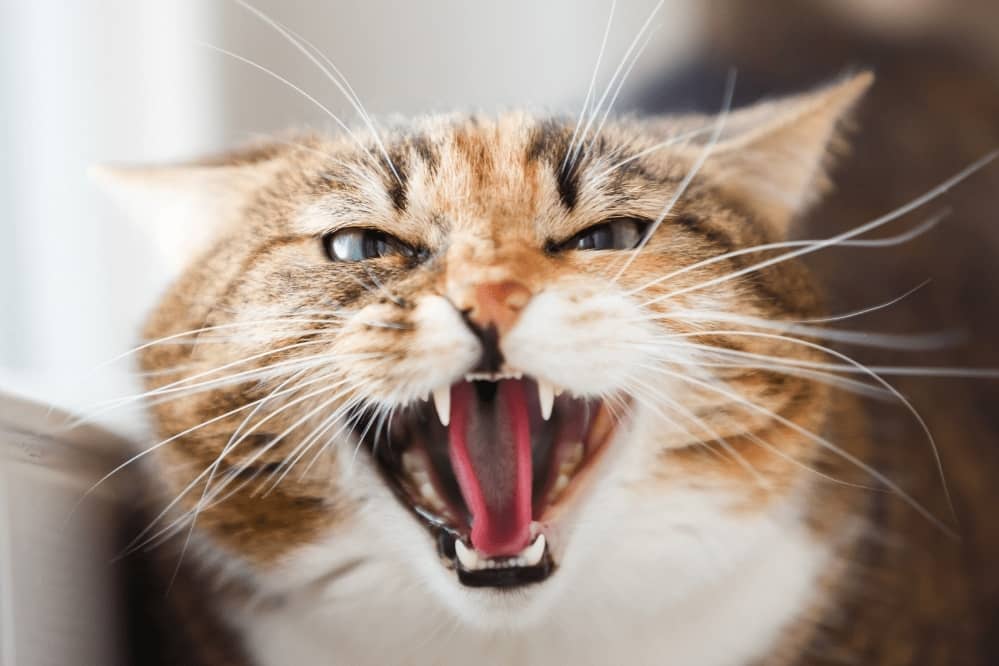Aggression may be defined as hostile or harmful behavior intended to dominate or intimidate another cat, animal or person. It is a common cat behavior problem and when left unattended to may lead to injuries to other cats and people, destruction of household items and even surrender of such cats to shelters.
Classification of cat aggression
A cat can display aggression for a variety of reasons. If your cat has been aggressive, take out time to evaluate the situations that got him upset as different types of aggression may be managed differently. Aggressive behavior in felines may be classified into the following categories:
Inter-Cat
Generally, inter-cat aggression is between two male felines, and it usually occurs as they approach social maturity between two and four years. The aggression may be triggered by body size (large cats often intimidate smaller ones), a personality clash or a lack of pleasant social experiences. If you observe this type of aggression between your cats, neutering or spraying should improve the situation as sexual hormones play an integral role here. If it does not work, separate the cats for a day or two and reintroduce them again.
Fearful or defensive
This type of aggression may be seen when your cat perceives a threat which could be a new person, animal, noise or an experience that he associates with unpleasant events. Typical body postures associated with this type of aggression may include: flattening his ears, baring his teeth, crouching low to the ground, hissing and spitting, and his fur may stand. The best way to calm your cat in this situation is to avoid him as an attempt to console him may be perceived as approval of aggression.
Territorial
Many animals tend to establish and defend their territories, and cats are not any different. Cats exhibit territorial aggression when people or other animals encroach upon their space. Sometimes, cats exhibit aggression to other cats that are new or even to old cats that have been away. A cat may mark his domain by patrolling, chin rubbing or urine spraying. In such situations, it helps not to rush the introductions or reintroductions as it may take some time for cats to accommodate other cats.
Play
Play aggression is often displayed by cats that did not play as kittens or cats that were not raised by littermates. The cat may have playful intentions, but such play could lead to rough play with other cats which can cause injury to them. Humans are not exempted as such cats may exhibit this type of aggression which may also cause injury and damage of household items. One way to pre-empt this aggression is to distract the cat at the early stages of play by using any object available.
Redirected
This a common type of aggression which is usually triggered by stimuli which a cat cannot respond to hence the attack is redirected to humans or animals. This is the most dangerous type of aggression as cats may bite and the attack could be damaging. Examples of stimuli that could trigger redirected aggression include: watching another cat through a door or window, stalking birds or other prey animals, loud noises etc. The most effective way to prevent this type of aggression is to remove or avoid the stimuli.
Petting-induced
Some pets do not like petting as they may feel irritated by it. Other times, it could be that your cat has had enough of the petting and feels controlled when it ends. Yet still, the petting could be unpleasant due to overstimulation which can trigger aggression in a feline. It is important to observe your cat’s body language as it is the best way to pick up the warning signals. A cat displaying this type of aggression may twitch or flip his tail, dilate his pupils, flatten his ears or become restless. The solution to this type of aggression is to avoid uninvited petting or stop petting him.
Pain-induced and irritable
Much like humans, cats may become aggressive due to pain, frustration or deprivation. The pain in cats is usually bodily and can be noticed when cats resent having a part of their body touched or manipulated. If your cat is showing aggression, one of the first things to look out for are signs of pains which could be caused by osteoarthritis, dental pain and abscesses from fighting. Additionally, painful punishments may also trigger aggression or worsen other types of aggression like fear and territorial aggression.
Maternal
Maternal aggression is common among cats that recently gave birth as they are usually protective of their kittens from potential danger. Cats that are nursing kittens may perceive approaching people or animals as threats and display aggression. If your cat just gave birth, it is a good idea to provide a quiet, low-stress environment and stay away from the kittens, especially during the first few days of delivery.
Conclusion
When you suspect that your cat is displaying signs of aggression, it is a good idea to visit your vet as feline aggression is mostly caused by a medical condition or complication. If your cat continues to exhibit signs of aggression, consult a professional animal behaviorist.

